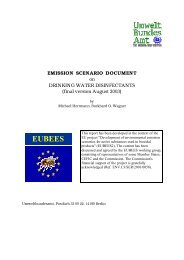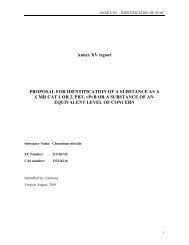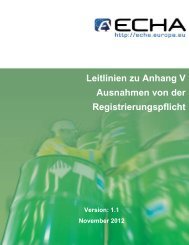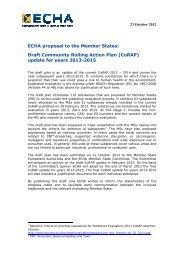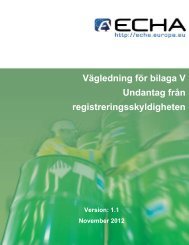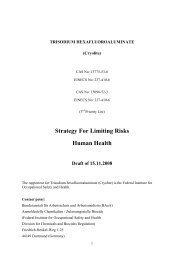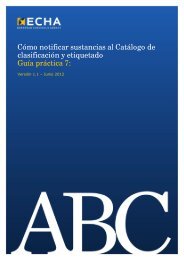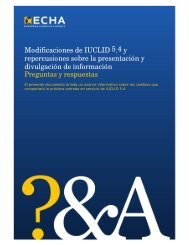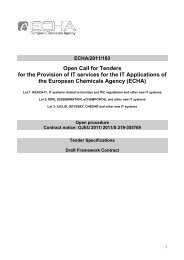Practical Guide 5: How to report (Q)SARs - ECHA - Europa
Practical Guide 5: How to report (Q)SARs - ECHA - Europa
Practical Guide 5: How to report (Q)SARs - ECHA - Europa
You also want an ePaper? Increase the reach of your titles
YUMPU automatically turns print PDFs into web optimized ePapers that Google loves.
2. HOW TO GET STARTED WITH (Q)SARS<br />
The use of (Q)SAR models with software is rather straightforward. <strong>How</strong>ever, experience<br />
and a thorough understanding of (Q)<strong>SARs</strong> will be needed when it comes <strong>to</strong> the<br />
assessment of whether predictions are reliable and adequate for the purpose of<br />
classification and labelling and/or risk assessment and can thus be used instead of<br />
testing.<br />
2.1. Substance characterisation<br />
The chemical structure needs <strong>to</strong> be well defined, following the Guidance on identification<br />
and naming of substances under REACH. All individual constituents of multi-constituent<br />
substances should be addressed. The composition of the well defined substances has <strong>to</strong><br />
include also known impurities (and additives, if any). For UVCBs, expert judgement is<br />
needed <strong>to</strong> decide whether structures can be identified which are representative for the<br />
substance. In case of a stable transformation product, it should be identified. A suitable<br />
structural representation for the chemical (SMILES, mol file etc.) is usually required.<br />
Stereochemistry should be taken in<strong>to</strong> account if necessary.<br />
2.2. (Q)SAR models<br />
SAR and QSAR models, collectively referred <strong>to</strong> as (Q)<strong>SARs</strong>, are theoretical models that<br />
can be used <strong>to</strong> predict in a quantitative or qualitative manner the physico-chemical,<br />
biological (e.g. a (eco)<strong>to</strong>xicological) and environmental fate properties of compounds<br />
from the knowledge of their chemical structure. A SAR is a qualitative relationship that<br />
relates a (sub)structure <strong>to</strong> the presence or absence of a property or activity of interest. A<br />
QSAR is a mathematical model relating one or more quantitative parameters, which are<br />
derived from the chemical structure, <strong>to</strong> a quantitative measure of a property or activity. In<br />
order <strong>to</strong> predict a property of a chemical, the validity of the selected (Q)SAR model<br />
should be assessed, and it should be verified that the chemical falls within the<br />
applicability domain <strong>to</strong> give a reliable prediction.<br />
2.3. Overall Assessment of adequacy and <strong>report</strong>ing<br />
In order <strong>to</strong> generate a reliable and adequate prediction of the presence or absence of a<br />
chemical’s property <strong>to</strong> fulfil the information requirements under REACH, (i) a (Q)SAR<br />
model should be used whose scientific validity has been established and (ii) the<br />
substance should fall within the applicability domain of the (Q)SAR model, (iii) the<br />
2






